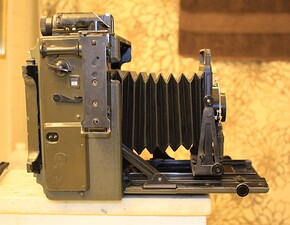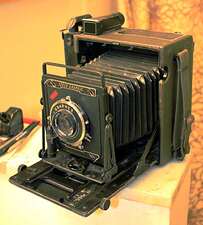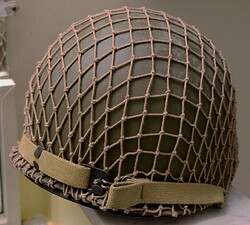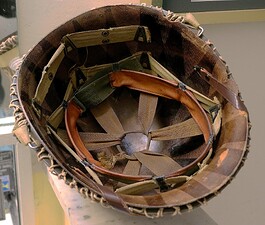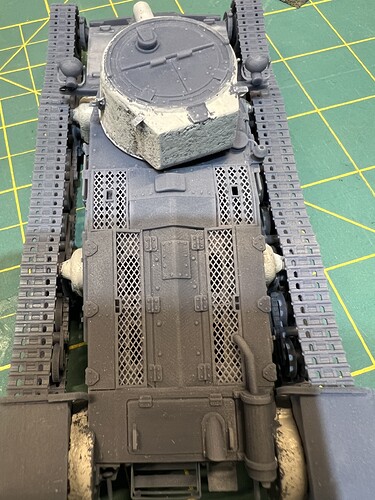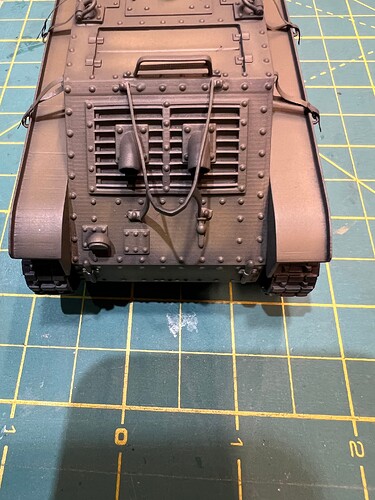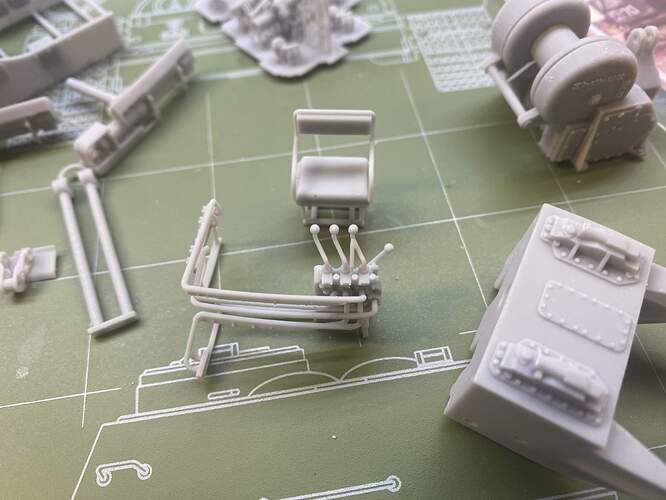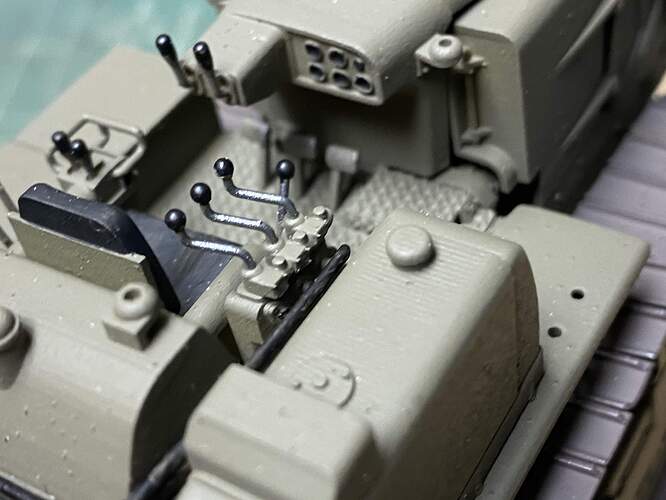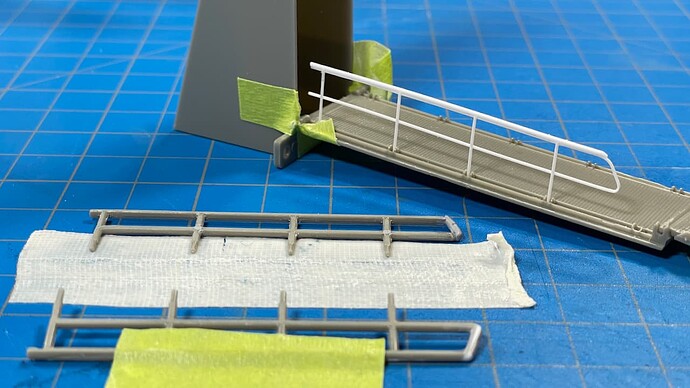Yep all fair comment – although would laser-cut card stock have the same combination of delicacy and strength that very thin brass does? Those railings needed a lot of handling & manipulation to get into place, the main problem was inadvertent bending. I always feared they’d fatigue/snap but they never did.
Tim, based on the samples I now have in my hands it think they would do just fine! Also it depends a lot on what cardstock you choose to use. Choosing something just a bit heavier, with a fine grain that is epoxy impregnated or enamel coated will do quite nicely.
Also Tim, I also suspect that what you really might have meant relative to 3D was the use of 3D printed parts that we design and print ourselves for our own model use:
My thoughts on that are as follows
- I own a top notch camera but I don’t bother to go out and buy a $12,000 dollar color printer/developer like the one they have that I use at the corner drug store. So why would I buy a 3D printer?
- So if I DO decide to learn to design 3D parts on my own computer, why would I buy a 3D printer? (Printer technology is advancing so rapidly and the printers are so temperamental, why would I ever invest my money there?)
- There seem to be many, many, MANY others (some on this site) far more interested in learning, designing, printing, producing & SELLING 3D parts. - I just don’t think I need to master this art. (I needed a rather simple 1/35th scale RR wheel as a replacement. I gave a sample to a young man that works at the local hobbyshop and he ran off 15 duplicate parts at home. I paid him $20 bucks but he offered to do it for free!)
- Personally I would much rather be the one to provide the research (something I DO like to do) and then help someone else to design, print & SELL the part.
- I suspect one day soon the corner drug store just might also have 3D printers where you can bring in you files and get them printed. There are already some store fronts opening up to offer this service.
EXAMPLES:
I provided the measurements, photographs and the construction details for producing this combat camera:
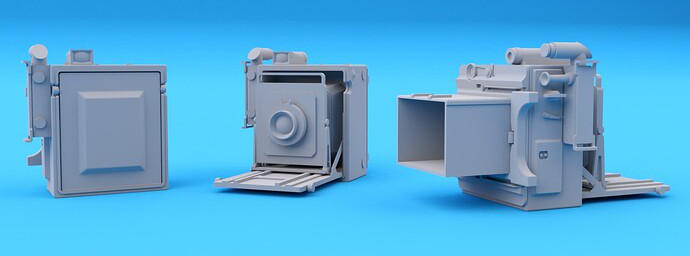
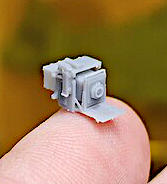
In this case I shipped my original helmet to the guy so he could scan it:
Never thought he would also do the INSIDE as well. AND in 1/35th no less!
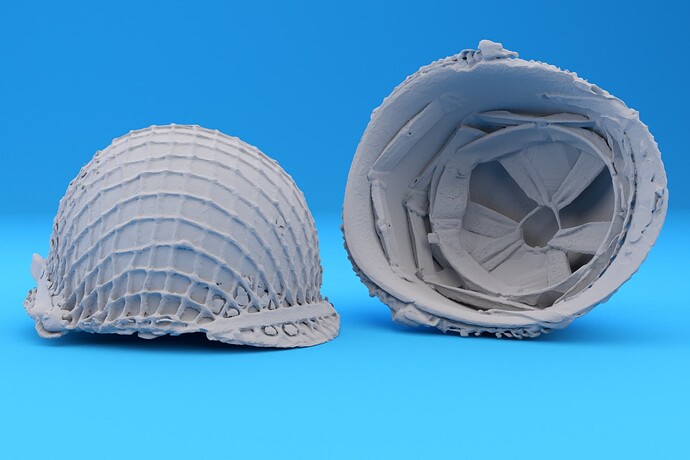
Right now I feel I kinda have the best of both worlds where 3D printed parts are concerned.
I like 3D printing etc and have zero issue with it being used in model building.
I do think there is a very substantial difference in 3D printed vs Aftermarket Resin:
3D printed part (digital source & digital copy, near infinite replication possible from same file, master file can be in mant places at once) Think MP3 music file.
Aftermarket Resin (analog source & analog copy, limited replication before latex mold wears out and needs replacement, bad chemicals, nasty dust if sanded dry etc). Think of as vinyl LP album.
Probably irrelevant to the point of being nearly silly in most regards except philosophy. I could imagine a certain “nerd faction” wanting their models “analog only” etc knowing how weird modelers can be on occasion.
I too, have no problems with one rubber mold producing dozens of identical resin copies just like I have no problem with one digital file producing dozens, if not thousands of copies.
Bear in mind the usual run on a plastic scale model is around 5000 units and they too are shipped all over the world so where do we draw the line on number of copies and their distribution?
The reverse of what I said earlier is the person who wants to sell their 3D computer file, e-mails it to you (i.e. no shipping charges) and you then produce as many copies as you wish on your own printer. *(They are doing that right now on the International Space Station! Launch only the printer and the raw materials and not heavy stocks of hundreds of repair parts.)
All this is very similar/identical to modern copyright laws and whatever the involved parties are happy with, so be it.
If you design something and sell just the file, then you should also include a disclamer “Copyrighted Material; For Personal Use ONLY.” (Again just like copyrighting a photo.)
Then later if you find them selling the part far and wide by the thousands (not likely to happen) then you sue them and take everything they have!)*
I have seen spokes for cars and motorcycles printed in 3D. Length might be the current issue but I think that will overcome in time. Some are printing Russian anti tank cages.
As for PE, you forgot/missed James’s work on the ST-26 Bridgelayer. Awesome project I need to move to the active pile soon.
Do like your fence.
Re 3D printing and the actual scale reproduction of parts: I believe it’s entirely possible to go too far. I bought a commercial rendition of M48 headlight assemblies that came with some very useful grab handles and lifting loops for the engine deck and covers. Absolutely lovely parts, but nearly impossible to remove from the printing supports without breakage. I get two good parts for every three hoops I attempt to use, and I’ve broken two of the four headlight assemblies.
Maybe designed too close to scale?
@rfbaer, That can certainly be a problem. That which will print sometimes won’t come off the supports. (in one piece.)
But I have certainly found that to also be true of some of the more finely done, high tech, plastic kits as well.
That’s true too. And part of my problem is surely me and my hams… er, hands.
Don’t know about this “analog only” way of thinking. I have a retired modeling buddy (age 83) that still feels strongly that 3D printed parts are “cheating!”
Personally I tend to think that any method that gets you to the structure or the affect you are after is fair game.
Lastly, there are NO modern plastic models out there today that have not been designed and “built” in CAD. After the files are edited they are then transfered to a numerically controlled (CNC) milling machine for the molds to then be routed out.
In my estimation there is no longer any such thing as a true “analog only” model unless perhaps you cut one out of the raw plastic yourself!
You might as well tell me I can’t use a part I just turned on my lathe. 3D printing is just another tool and a darn good one at that, and getting better!
Or go old school and do it out of wood?
Ken
RIGHT; whittle yourself up a Tiger out of a block of wood! (with a full interior.)
Mike as a Model RR guy you must have heard of Ernst Warther out of Dover, Ohio. Truly old school and w/full interior and working mechanisms.
Tim
I’m not saying anything is impossible, just asking “do we want to push such a creative tool as CAD and 3D Printing out of our world?” Why would we?
Trundling that train of thought on to the next station, is there anything 3D printing can’t handle very well (if at all) yet? I think so – very fine/thin/delicate elements. For some time photo-etch brass has been the default solution, but only if a manufacturer provided it.
@Dioramartin 3D printers and the CAD modelers behind them are getting much better at doing extremely fine work. Here is an example of engine grates that were printed in place. They are as fine as any PE and are 3-dimensional.
And a bracket.
Previously these would only have been possible in PE. Now, we have options.
Here are some very small Hobby Link 3D printed parts for a Cat D7E Rome plow.
Manifold block, hoses and control levers.
Imagine how many pieces this would be on a styrene kit or how one of you guys would go about scratching this.
I really believe this is the future of model making.
I would have soldered this… if I had soldering skills… or 3D Printed it in a heartbeat… if I had a printer. ![]()
![]()
—mike
You’re a better man for having done it the old fashioned way. ![]()
![]()
![]()
![]()
Maybe not a Tiger, but I have an M1 Garand and Winchester Model 94 in Wood and metal.
Ken
